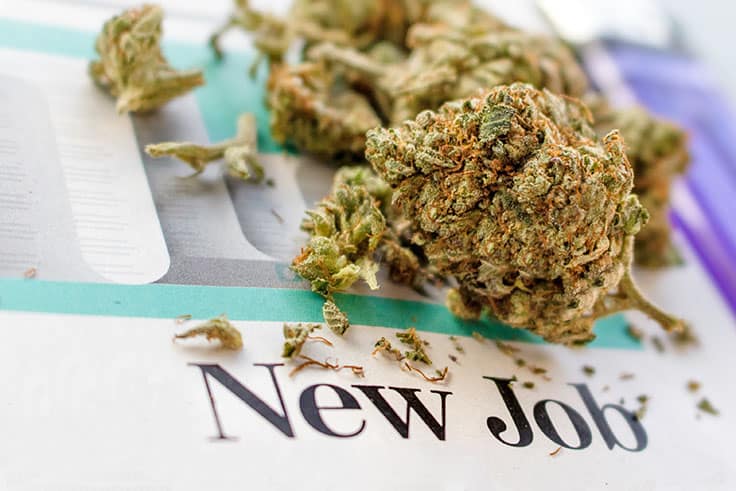

Shannon Price | Adobe Stock
Job growth in the cannabis sector doesn’t appear to be slowing down anytime soon.
The legal cannabis industry now supports 321,000 workers in the United States, with 77,000-plus jobs created in 2020, or roughly a 32% increase across the 37 states and the District of Columbia with medical or adult-use markets, according to a report by Leafly.
While cannabis companies were not immune to layoffs and furloughs during the onset of COVID-19, as job growth experienced a lull between March and August, hiring picked back up, and many operations thrived during the pandemic. The year-over-year growth showed that the cannabis sector created jobs at a faster rate than almost any other American industry, according to Leafly.
James Yagielo, the CEO of HempStaff, a recruiting and training company based in Miami that specializes in the cannabis and hemp industries, said the 32% increase reported by Leafly did not leave him open-mouthed.
“It was not really that surprising because it was essential business, so that really narrowed down a lot of the different industries because a lot of industries are not essential,” he said. “So, I think that may have definitely skewed the numbers in cannabis’ favor. But, additionally, even though last year was a horrendous year for most people, our recruiting numbers pretty much matched 2019. We didn’t get the increase we expected, but we didn’t really get decrease either.”
When September 2020 hit, job growth picked back up in the sector, Yagielo said.
“We’ve kind of had a boom, say, post Labor Day in the cannabis industry in hiring that to [this] day is still going on,” he said. “So, while we did have that few-months lull, it really picked back up once they realized that the cannabis industry was not going to be hurt by the pandemic.”
The 32% increase in job growth in the cannabis sector came at a time when the broader U.S. economy shrank by 3.5% in 2020, according to the Bureau of Economic Analysis.
Although the cannabis industry may have appeared recession-proof to some, Vangst, a Denver-based recruiting platform that connects cannabis job seekers with employees, reported 80% of its clients had to lay off or furlough employees when stay-at-home orders rolled out at the onset of COVID-19, CEO Karson Humiston said.
“Nobody knew how the cannabis industry would respond to really its first economic downturn,” she said. “And, at the end of the day, cannabis was deemed essential and businesses did well, and people continued purchasing, consuming cannabis, but nobody knew that that would happen. And, so, capital stopped blowing into the space, which is a big driver of expansion, and businesses really kind of reined in their growth and expansion plans to see how the year would shake out.”
By the end of the year, companies were back on track with their hiring plans, Humiston said.
“Fortunately, the year went great and the election results were great, and I think that’s setting us up for huge, huge, huge growth potential in 2021 and beyond for jobs and cannabis,” she said.
With the hiring increase experienced in 2020, the U.S. cannabis industry now supports nearly as many jobs as there are firefighters in the country, according to U.S. Bureau of Labor Statistics.
As employment continues to heat up, so are salaries and benefits in the sector, Humiston said. According to Vangst’s 2020 Cannabis Industry Salary Guide released last month, 83% of cannabis companies Vangst surveyed offer paid-time off, 73% offer medical insurance, 63% offer dental insurance, 62% offer vision insurance, 28% offer equity or stock options and 29% offer 401(k) plans—a more than 10% year-over-year increase.
“You have to remember the cannabis industry is a startup,” Humiston said. “The entire industry is a startup. This is one of the most immature market industries in the country, and yet they’re providing these great benefits and every year they keep on getting better. And, so, I think this industry is doing a great job in terms of how it’s paying its employees and in terms of the benefits that it’s providing.”
According to Cannabis Business Times and Cannabis Dispensary’s recent Best Cannabis Companies To Work For research, many employees are not satisfied with their pay and benefits, according to anonymous questionnaires distributed to teams of companies that applied to be in the program. The feedback showed 65% of cultivation employees at Best Cannabis Companies said they agreed their pay was fair for the work they perform, while that number was 59% for companies that applied but did not rank. Those numbers were 78% for dispensary employees working for top companies and 60% for others.
Budtenders, trimmers/post harvesters, packagers and delivery drivers in the 15 select states surveyed in Vangst’s guide made an average wage of $15 to $16 per hour, while some of the higher-paid jobs, like vice presidents of retail operations, manufacturing or sales, and directors of cultivation or extraction, all earned averaged salaries in the range of $105,000 to $160,000.
At HempStaff, Yagielo said the biggest increase in salary his company has noticed is for testing lab managers.
“There’s a lot of testing labs across the country trying to get online, when there’s not a lot of people that are your high-level Ph.D. scientists to get a lab set up,” he said. “So, we’ve seen, you know, salaries of lab managers go up above the $200,000-a-year mark recently. They’re usually looking for a Ph.D. in chemistry or something along those lines.”
When new states enact medical or adult-use cannabis programs, there’s often a big rush to relocate top-level managers to those states, whether it be for cultivation, extraction, manufacturing, retail or testing lab operations, Yagielo said. And once those people are relocated, then they start hiring their staff locally, he said.
“And these newer states tend to bump up salaries to entice people, because you’re going to have not as many growers that want to leave a state like Colorado, that’s totally legal, to go to a Mississippi, [which just passed medical cannabis legalization in the November 2020 election],” Yagielo said.
According to Leafly, more than 35,500 Coloradans are employed by the cannabis industry, where sales began in 2014 and raked in $2.2 billion in 2020. Colorado is only outdone by California, which supported roughly 58,000 cannabis jobs in a $4.4 billion market in 2020.
In New Jersey, where Gov. Phil Murphy signed legislation Feb. 22 to legalize adult-use cannabis following voters’ approval of the constitutional amendment, job numbers are estimated to grow by 25,000 in the sector during the first year it enacts a program, Humiston said.
“That’s a lot of brand-new jobs being created, in addition to all the tax revenue that’s being created,” she said. “I mean, cannabis creates jobs, period, and helps communities help people get to work.”
When asked if some of the more mature markets, like Colorado and California, will level off with future job growth, Humiston said she doesn’t see that happening anytime soon.
“The beauty is that more and more consumers are coming into the market every year,” she said. “There’s a whole population of people that haven’t tried cannabis yet. As those consumers continue to become customers, the businesses continue growing. And, so, we’ve certainly seen a level of consolidation, but, if you look at the market trends, the market has continued to grow every single year since it legalized. And as the market grows, meaning just general cannabis sales, there’s a need for more employees.”
With the need for more employees comes the need for job-seeking candidates, who are not on short supply for many entry-level positions. Yagielo said he sees anywhere from 100 to 300 resumes for each job opening, with the number ranging on the high end for budtender positions. But future demand could come by way of factory jobs, he said.
While cannabis job growth has continued to boom, the United States’ industrial hemp industry has leveled off in the past year or so because of market saturation without enough factories to support it, Yagielo said.
“Until you have more of those factories, unfortunately, there is a lot of hemp just getting moldy in people’s barns,” he said. “When [more infrastructure is created], I think your job market is going to explode, because factories need thousands of people to run them.”
Both Humiston and Yagielo said there’s a direct correlation between more capital entering the space and increased hiring in the industry.
In addition to more states coming on board with cannabis legalization, financing options at the federal level would bring a new round of capital into the industry, Humiston said. The Secure And Fair Enforcement (SAFE) Banking Act—proposed legislation regarding the disposition of funds gained through the cannabis industry in the U.S.—would open those doors, she said.
In other words, some companies that have the financial wherewithal to join space in the industry haven’t yet pulled the trigger without fiscal confidence at the federal level.
“I think the other big factor outside of states becoming legalized is businesses having access to capital,” Humiston said. “As businesses can take on more traditional financing options, that will allow them to grow and expand and hire more people. So, I think SAFE Banking is a big bill that everybody’s kind of paying attention to, hoping that that pushes through.
“And then just as more investors get comfortable with the space, capital will lead to growth, which the No. 1 thing people do when they grow is hire.”
